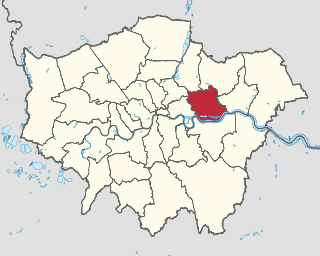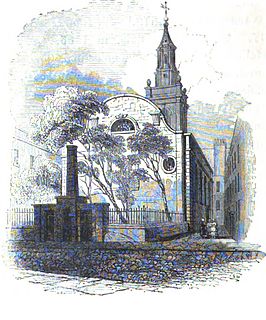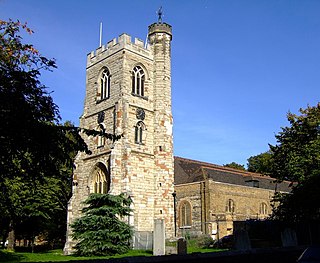
Stratford is a town in east London, England, within the ceremonial county of Greater London and the historic county of Essex. Part of the Lower Lea Valley, Stratford is situated 6 miles (10 km) east-northeast of Charing Cross, and includes the localities of Maryland, East Village, Mill Meads and Stratford City.

West Ham is a district in East London, located 6.1 mi (9.8 km) east of Charing Cross in the west of the modern London Borough of Newham. The West Ham electoral ward covers part of the central area of that borough.

The London Borough of Newham is a London borough created in 1965 by the London Government Act 1963. It covers an area previously administered by the Essex county boroughs of West Ham and East Ham, authorities that were both abolished by the same act. The name Newham reflects its creation and combines the compass points of the old borough names. Situated on the borders of inner and outer East London, Newham has a population of 353,134, which is the third highest of the London boroughs and also makes it the 20th most populous district in England. The local authority is Newham London Borough Council.

West Ham was a local government district in the extreme south west of Essex from 1886 to 1965, forming part of the built-up area of London, although outside the County of London. It was immediately north of the River Thames and east of the River Lea.

St Michael Bassishaw, or Basinshaw, was a parish church in Basinghall Street in the City of London, standing on land now occupied by the Barbican Centre complex. Recorded since the 12th century, the church was destroyed in the Great Fire of 1666, then rebuilt by the office of Sir Christopher Wren. The rebuilt church was demolished in 1900.

Stratford Langthorne Abbey, or the Abbey of St Mary's, Stratford Langthorne was a Cistercian monastery founded in 1135 at Stratford Langthorne — then Essex but now Stratford in the London Borough of Newham. The Abbey, also known as West Ham Abbey as it lay in that parish, was one of the largest Cistercian abbeys in England, possessing 1,500 acres (6.07 km2) of local land, controlling over 20 manors throughout Essex. The Abbey was self-sufficient for its needs and wealthy besides; some of this wealth came from the ecclesiastic mills grinding wheat for local bakers to supply bread to the City of London. This later led to competition with the Guild of Bakers, who sought powers to levy a toll on loaves entering the City at Whitechapel.

The Parish Church of St Luke, Chelsea, is an Anglican church, on Sydney Street, Chelsea, London SW3, just off the King's Road. Ecclesiastically it is in the Deanery of Chelsea, part of the Diocese of London. It was designed by James Savage in 1819 and is of architectural significance as one of the earliest Gothic Revival churches in London, perhaps the earliest to be a complete new construction. St Luke's is one of the first group of Commissioners' churches, having received a grant of £8,333 towards its construction with money voted by Parliament as a result of the Church Building Act of 1818. The church is recorded in the National Heritage List for England as a designated Grade I listed building. The gardens of St Luke's are Grade II listed on the Register of Historic Parks and Gardens.

All Saints Church is a parish church in West Ham, an area in east London. It has been a Grade I listed building since 1984.

St John's Church or the Church of Saint John the Evangelist is the parish church in Stratford, London, standing on Stratford Broadway, the main thoroughfare.

St Mary's Church is a Church of England church in Plaistow, east London. With the three churches of St Matthias’, St Martin's, and St Philip and St James’, it now forms part of the Parish of the Divine Compassion. Its Victorian building, designed by Sir Arthur William Blomfield in 1890-1894, was demolished in 1976. They now worship in a smaller church built in 1981.

Holy Trinity Church was a Church of England parish church in Canning Town, east London. Its origins were in the Plaistow and Victoria Docks Mission, set up to serve the growing area of Hallsville by the vicar of St Mary's Church, Plaistow and Antonio Brady. It initially worshipped in the National School on Barking Road until the permanent church opened in 1867, with a parish formed for it the following year by parts of St Mary's and All Saints. Its advowson was initially vested in the bishop, but transferred to the Lord Chancellor in 1886 to allow the benefice of Holy Trinity to be supplemented from revenues from All Hallows Church, London Wall.

Emmanuel Church, Forest Gate is a Church of England church in Forest Gate, east London. It was built in the Decorated Gothic variant of the neo-Gothic style in 1852 to designs by George Gilbert Scott and a new parish formed for it from parts of All Saints Church, West Ham and St Mary Magdalene's Church, East Ham. A north aisle was added in 1890. Bomb damage from the London Blitz was repaired. It was Grade II listed in 1984.

St Luke's Church, Canning Town or St Luke's Church, Victoria Docks is a Church of England church, originally housed in a building on Boyd Road in the Royal Docks area of West Ham in east London.

St Paul's Church, Stratford is a Church of England church in Stratford, London. It had its origins in a Sunday School opened in Stratford New Town by a City Missionary around 1850, for which a building was constructed on Queen Street by Samuel Gurney in 1853, within the parish of St John's Church, Stratford. St John's vicar William Holloway was ambivalent about the mission and so friction arose when the vicar of All Saints, A J Ram, bought a site for the mission to build a church, initially an iron hall in 1859 and a permanent church in 1864, both dedicated to St Paul. The latter was built with assistance from Thomas Fowell Buxton and Raymond Pelly. The permanent church was then assigned a separate parish in 1865, split from that of St John's. The church was destroyed by a V-weapon in 1945, but was replaced by a new building, consecrated in 1953.
St Gabriel's Church, Canning Town was a Church of England church in Canning Town, east London. It originated as an undedicated iron church between the River Lea and the railway to the north of the Barking Road, on the site later used for the brick-built permanent church of St Gabriel's, consecrated in 1876. Initially a mission of All Saints Church, West Ham, it was given a parish of its own three years after the consecration, using parts of those of All Saints, St Mary's and St Andrew's. It was damaged in the London Blitz and demolished around 1955, with its parish split between St Matthias and St Luke's in 1961.
St James' Church, Forest Gate was a church in Forest Gate, east London. Its origins lay in an iron building constructed around 1870 to serve a conventional district. A parish was formed for it in 1881 from those of Emmanuel Church, All Saints and St John's and its permanent church completed the following year, with an organ moved from St Matthew's Church, Friday Street. The church was demolished in 1964 and for two years its congregation worshiped in the Durning Hall Community Centre's chapel until the parish was merged with that of St John's. A new church was built for the St James' congregation at northern end of St James Road in 1968. The congregation finally moved to St Paul's Church, Stratford in 2014, though the area that had formerly been St James' parish was instead transferred from St John's to St Saviour's the same year.
St Saviour's Church is a Church of England church in Forest Gate, east London. It was opened by Emmanuel Church, Forest Gate as a mission hall in 1880, with a separate parish and a permanent church following three years later. Its first vicar was Henderson Burnside, one of the first Anglican missionaries in Japan. It opened a mission at "365 Railway Arches" in 1903. Its parish is now known as 'St Saviour's and St James's, Forest Gate' after the area formerly forming the parish of St James' Church, Forest Gate was transferred to it in 2014 - the congregation from St James', however, transferred to St Paul's Church, Stratford, also in 2014.
St Thomas's Church, West Ham, was a church in West Ham, East London. It originated around 1878 on Rokeby Street as a mission of All Saints Church, West Ham, initially in an iron building and then from 1889 in a brick one, which was assigned a parish from All Saints' in 1891. It was damaged by bombing, closed and finally demolished in 1957, though the parish existed until 1961, when it was merged back into that of All Saints.
St Peter's Church was a Church of England church on Upton Lane in the Upton Cross area of Newham, East London. Its origins were in a mission of St Mary's Church, Plaistow on Pelly Road, holding services in a barn then in an iron church. Joseph Lister's former home Upton House was bought by the bishop of St Albans in 1885, becoming the vicarage, whilst its garden provided the site for a permanent church, built in 1893 and given a separate parish the following year using parts of those of All Saints, St Mary's, Emmanuel and St Stephen's. The parish was merged into that of Emmanuel in 1962 - the church was left standing as a chapel of ease to Emmanuel, but its vicarage was demolished, the site being sold in 1968. Funds from that sale and the sale of the parish hall were intended for a new church, church hall and clergy house, but in 1972 St Peter's Church was declared redundant, demolished and its site sold off, leading to the scheme's abandonment three years later.

St Francis of Assisi Church is a Roman Catholic parish church in Stratford, London. It was founded from a mission that started in 1770. The church itself was built in 1868. The church is located on the corner of Grove Crescent Road and The Grove, and is accessible from both streets. The Franciscan Order of Friars Minor arrived in 1873, built a friary next door to the church in 1876 and continue to serve the parish.














